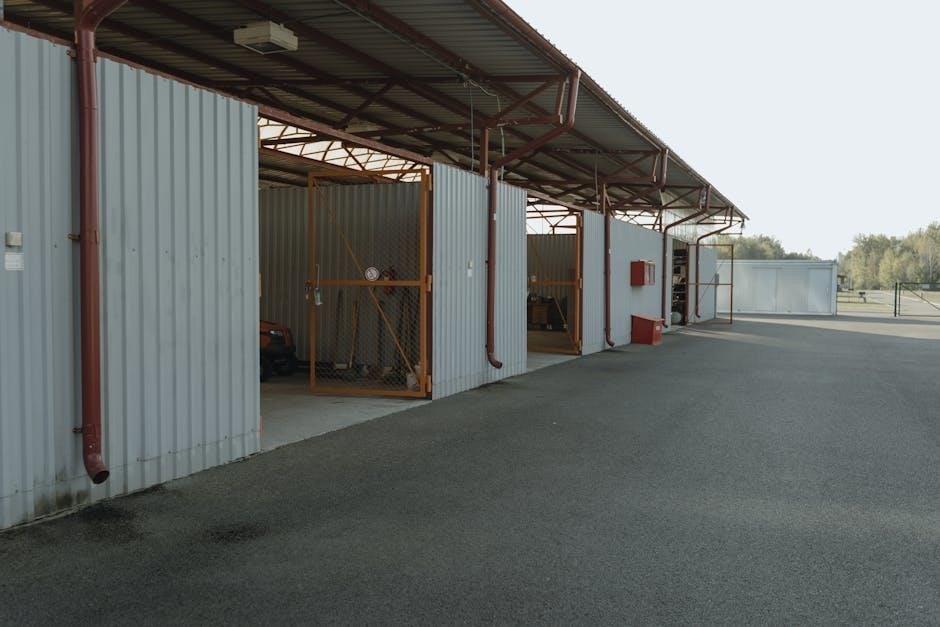Manually opening a garage door with a broken spring is a challenging task that requires caution and understanding of the door’s mechanics. The absence of a functional spring means the door loses its counterbalance, making it heavier and more dangerous to handle. This situation often arises unexpectedly, leaving homeowners in need of immediate solutions to access their garage. While it’s crucial to address the issue promptly, safety should never be compromised. This guide provides a comprehensive approach to manually opening a garage door with a broken spring, emphasizing safety measures and practical steps to regain access while minimizing risks of injury or further damage.
1.1 Understanding the Risks and Importance of Manual Operation
Manually opening a garage door with a broken spring poses significant risks, including potential injury from the door’s weight and further damage to the mechanism. The door becomes unbalanced, making it harder to control, and improper handling can lead to accidents. Understanding these risks is crucial to ensure safety and avoid worsening the issue. Manual operation is essential for regaining access and preventing further complications, but it must be approached with caution and awareness of the potential hazards involved.
1.2 Key Concepts for Safe and Effective Manual Opening
Manual opening of a garage door with a broken spring requires understanding the emergency release cord’s role and proper lifting techniques. Ensure the door is balanced and free from obstructions before attempting to lift. Always prioritize stability and control to prevent accidents. Using assistive tools, like a second person or a lever, can enhance safety and make the process more manageable. Proper preparation is key to avoiding further damage or injury.

Assessing Safety Before Manually Opening the Garage Door
Always inspect the door for structural integrity and ensure it is secure. Check for additional damage or hazards that could complicate manual operation. Safety first!
2.1 Checking for Additional Damage or Hazards
Before manually opening, inspect the door and surrounding area for additional damage, such as bent tracks, worn rollers, or loose springs. Ensure no obstructions block the door’s path. Verify the door’s balance and stability to prevent unpredictable movement. Addressing these issues first minimizes risks of injury or further damage during the manual opening process.
2;2 Ensuring Proper Door Balance and Stability
Before manual operation, ensure the garage door is properly balanced and stable. A broken spring disrupts the door’s weight distribution, making it unsafe to open. Check if the door stays in place when partially lifted. Verify alignment with tracks and ensure rollers are not obstructed. A well-balanced door reduces the risk of accidents and makes manual opening safer and more manageable.

Steps to Manually Open a Garage Door with a Broken Spring
Manually opening a garage door with a broken spring requires disconnecting it from the opener and lifting it carefully. Ensure the door is stable and safe to handle. This temporary solution allows access until professional repairs are made.
3.1 Locating and Pulling the Emergency Release Cord
The emergency release cord, typically a red handle or rope, is attached to the garage door trolley. To disconnect the door from the opener, gently pull the cord down while ensuring the door is closed. This action releases the door from the opener’s mechanism, allowing manual operation. Always verify the door’s stability before proceeding to lift it manually.
3.2 Lifting the Door Manually with Proper Technique
Once the emergency release cord is pulled, grip the door firmly at the bottom edge or handle. Stand centrally, bend at the knees, and lift with your legs to avoid straining your back. Push upward smoothly, maintaining control to prevent sudden movements. If the door feels too heavy, stop immediately and seek assistance to avoid injury or further damage.

Tools and Materials Needed for Manual Operation
A coat hanger, hooked wire, or emergency release cord are essential. A wedge or milk crate can assist in lifting, while gloves provide grip and protection.
4.1 Essential Items for Safe and Effective Door Handling
To manually open a garage door with a broken spring, essential items include a sturdy coat hanger or hooked wire for engaging the emergency latch, gloves for better grip, and a wedge or milk crate for support. Additionally, a red emergency release cord is crucial for disengaging the opener mechanism. These tools ensure safe and controlled manual operation, minimizing risks of injury or further damage to the door system.
4.2 Alternative Methods for Emergency Latch Release
When the emergency release cord is inaccessible, alternative methods include using a sturdy coat hanger or hooked wire to engage the latch. A wedge or milk crate can also provide support to hold the door in place while manually lifting. These tools help bypass the automatic mechanism safely, ensuring the door can be opened without causing further damage or risking injury.
Maintaining Safety While the Spring is Broken
Maintaining safety is crucial while the spring is broken. Secure the door with clamps or locks to prevent accidental movement. Always keep children and pets away while working on the door. Use warning signs to alert others of the hazard. Never attempt to lift the door without proper support to avoid injuries or further damage.
5.1 Avoiding Further Damage to the Door and Mechanism
Avoiding further damage requires careful handling of the door and its components. When the spring is broken, the door becomes unbalanced, making it prone to additional stress. Refrain from forcing the door open or closed, as this can damage the tracks, rollers, or cables. Use clamps or locking pliers to hold the door in place while working on it. Never attempt to lift the door without proper support, as sudden movements can cause misalignment or breakage. Regularly inspect the door’s condition and avoid using temporary fixes that might exacerbate the issue. Professional assistance is recommended to prevent further harm to the mechanism.
5.2 Preventing Accidental Door Movement
Preventing accidental door movement is critical for safety when the spring is broken. Always engage the emergency lock or use clamps to secure the door in place after manual opening. This prevents unintended movement caused by wind or vibrations. Ensure the door is fully closed or open before leaving it unattended. Using wedge devices or supports can also stabilize the door, reducing the risk of sudden drops or shifts. Regular checks on the door’s position and locks help maintain control and prevent accidents.
Understanding the Role of the Emergency Release Cord
The emergency release cord disconnects the garage door from the opener, allowing manual operation when the spring breaks. It’s typically a red cord, easy to locate, ensuring quick action during emergencies to regain door control safely and effectively.
6.1 Locating and Identifying the Emergency Release Mechanism
The emergency release mechanism is usually a red cord or handle attached to the garage door opener. It’s designed to be easily visible and accessible, often hanging from the trolley system near the door. Identifying it correctly ensures quick disengagement of the opener, allowing safe manual control of the door, especially when the spring is broken and the door is unbalanced.
6.2 Properly Engaging and Disengaging the Cord
Engaging the emergency release cord disconnects the door from the opener, allowing manual control. To disengage, firmly pull the red cord downward until it clicks. Ensure the door is fully closed before disengaging. When ready to reconnect, align the opener and gently tug the cord until it reattaches. Always maintain control of the door during these steps to prevent sudden movements and potential injury.
Handling a Stuck or Difficult-to-Lift Garage Door
A stuck or difficult-to-lift garage door requires careful handling to avoid injury or further damage. Use proper lifting techniques and ensure the door is balanced before attempting to open it manually.
7.1 Using Additional Support or Tools for Easier Lifting
Use a coat hanger or hooked wire to engage the emergency latch. Tools like a pry bar or long-handled wrench can provide extra leverage. Consider enlisting help to distribute the weight evenly. Place a wedge under the door for stability once lifted. Ensure all tools are secure to avoid accidents and further damage. Always prioritize safety when using additional support for lifting a difficult-to-lift garage door with a broken spring.
7.2 Addressing Obstructions or Misaligned Tracks
Check the tracks for debris or obstructions that may hinder smooth movement. If misaligned, gently tap the tracks back into place with a rubber mallet. Lubricate rollers to reduce friction. Ensure all bolts are tightened securely. Addressing these issues can make manual lifting safer and more manageable, especially with a broken spring. Always inspect tracks before attempting to lift to prevent further complications.
Preventing Future Spring Breaks and Maintenance Tips
Regular lubrication of moving parts and inspection of springs can prevent future breaks. Replace worn-out components promptly to ensure smooth operation and longevity of the garage door system.
8.1 Regular Inspection and Lubrication of Moving Parts
Regular inspection and lubrication of garage door components are vital for preventing spring breaks. Check springs, rollers, and hinges for wear. Lubricate all moving parts with silicone-based spray to reduce friction and extend their lifespan. This maintenance ensures smooth operation and helps prevent unexpected failures, keeping your garage door functioning safely and efficiently over time.
8.2 Signs of Wear That May Indicate an Impending Break
Identifying signs of wear is crucial to prevent spring breaks. Look for rust, uneven door movement, or loud noises during operation. If the door sags or one side hangs lower, the springs may be weakening. Addressing these issues early can prevent sudden breaks, ensuring your garage door operates safely and reliably without unexpected failures or safety hazards.

Additional Tips for Safe and Effective Manual Operation
Use assistive devices like pulleys or clamps for heavy doors, and always lift with proper technique to avoid injury. Know when to call a professional if unsure.
9.1 Using Assistive Devices for Heavy or Unbalanced Doors
For heavy or unbalanced doors, use assistive devices like pulleys, clamps, or rope systems to distribute weight evenly. These tools can help lift the door safely, reducing strain and risk of injury. Placing a wedge under the door for support can also prevent sudden movements. Always ensure proper alignment and consult a professional if the door feels too cumbersome to handle manually.
9.2 Knowing When to Call a Professional for Assistance
If the door is severely unbalanced, excessively heavy, or shows signs of structural damage, it’s crucial to seek professional help. Attempting to lift it manually in such cases can lead to accidents or further damage. A professional can assess the situation, repair or replace the spring safely, and ensure the door operates properly. Prioritize safety by recognizing when the task exceeds your capabilities.
Manually opening a garage door with a broken spring is risky due to the door’s weight and potential instability. Always prioritize safety by ensuring proper support and considering professional assistance to avoid accidents and ensure a correct repair.
10.1 Recap of Key Safety Measures
Always ensure the door is fully supported when manually opening to prevent it from falling. Wear protective gear and avoid standing directly under the door. Never lift a door with broken springs alone or without securing it properly. Keep children and pets away during the process. Regular inspections and timely spring replacements are essential for maintaining garage door safety and functionality.
10.2 Encouragement for Timely Spring Replacement
Addressing a broken spring promptly is vital to prevent further damage and ensure safety. Delaying replacement can lead to more costly repairs and potential harm from an unstable door. Regular maintenance and inspections help identify wear early, allowing proactive replacement. A functional spring ensures smooth operation and security, making timely replacement a wise investment for homeowners.
